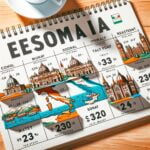What is the cheapest time to travel to Italy? This is a question that many budget-conscious travelers ask themselves when planning a trip to this beautiful and historic country.
The significance of finding the cheapest time to visit Italy cannot be overstated, as it can greatly impact the overall cost of your trip. By choosing the right time to travel, you can save money on airfare, accommodation, and even activities, allowing you to make the most of your travel budget.
Peak vs. Off-Peak Seasons play a significant role in determining travel costs and experiences in Italy. The contrast between high tourist seasons and off-peak seasons can have a significant impact on pricing, availability, and overall enjoyment of your trip. Weather conditions throughout the year also play an important role in determining travel costs, as certain times of the year may be more desirable for travelers due to favorable weather conditions.
In addition to weather considerations, festivals and events in Italy can also affect travel prices. Major festivals and events draw large crowds of tourists, affecting both airfare and accommodation costs. Understanding these factors can help travelers plan their trips strategically to save money while still experiencing the best that Italy has to offer. Ultimately, choosing the cheapest time to travel to Italy requires careful consideration of various factors such as tourist trends, local events, weather patterns and travel costs.
Peak vs Off-Peak Seasons
When planning a trip to Italy, it’s essential to consider the timing of your visit in order to save money. Understanding the peak and off-peak seasons and their pricing differences can significantly impact your travel budget.
Peak Seasons
Italy’s peak tourist seasons typically occur during the summer months, from June to August. This is when the weather is at its warmest, and many travelers flock to popular destinations such as Rome, Florence, and Venice. As a result, accommodation prices tend to skyrocket during this time, along with airfare and attraction entrance fees. It can be difficult to find budget-friendly options during these months due to high demand.
Off-Peak Seasons
Conversely, traveling during the off-peak seasons in Italy can provide an opportunity for significant cost savings. The shoulder seasons of spring (April to May) and fall (September to October) offer milder weather, fewer crowds, and more affordable prices for accommodations and airfare. Additionally, visiting Italy during the winter months (November to February) can also result in reduced travel costs, although some attractions may have limited operating hours.
By understanding the differences between peak and off-peak seasons in Italy, travelers can make informed decisions about when to visit based on their budget and preferences. It’s important to weigh the benefits of lower prices against potential limitations in terms of weather or seasonal closures of certain attractions. Making a thoughtful choice about when to travel can lead to a more enjoyable experience while saving money on your Italian adventure.
Weather Considerations
Italy experiences a Mediterranean climate, characterized by hot, dry summers and mild, wet winters. The weather plays a significant role in determining the cheapest time to travel to Italy. Generally, the peak tourist season in Italy is during the summer months of June, July, and August when the weather is warm and sunny.
As a result, travel costs including airfare and accommodation tend to be higher during these months. Conversely, the off-peak seasons of fall (September to November) and spring (March to May) can offer more affordable options for travelers.
During the shoulder seasons of spring and fall, visitors can enjoy pleasant temperatures, fewer crowds at popular tourist attractions, and lower prices for accommodations and flights. Additionally, exploring Italy during these times allows travelers to experience the stunning autumn foliage or vibrant spring blooms.
When considering how weather impacts travel costs in Italy, it’s important to note that while winter (December to February) is considered the low season due to cooler temperatures and some regions experiencing snowfall, it can also present opportunities for budget-friendly travel. Many hotels offer discounted rates during this time, making it an attractive option for those looking to save on their trip expenses.
It’s essential for travelers to consider their preferred weather conditions when planning a trip to Italy as this will influence both travel costs and the overall experience. Understanding how weather impacts pricing can help individuals make informed decisions about when to visit this beautiful country.
| Month | Temperature Range |
|---|---|
| June-August (Peak Season) | 70-85°F |
| September-November (Fall/Shoulder Season) | 55-70°F |
| December-February (Low Season) | 30-50°F |
Festivals and Events
Italy is a country known for its rich cultural heritage and vibrant festivals and events. These celebrations attract tourists from all over the world, but they can also have a significant impact on travel prices. Understanding the major festivals and events in Italy can help travelers plan their trip during the cheapest time to visit this beautiful country.
Major Festivals and Events
Italy hosts numerous festivals and events throughout the year, each with its own unique traditions and cultural significance. From Carnevale in Venice to the Palio di Siena and the Venice Film Festival, there is no shortage of exciting events to experience in Italy. However, these popular events often lead to an influx of tourists, resulting in higher travel costs for accommodations, airfare, and attractions.
Impact on Travel Prices
During major festivals and events, demand for accommodations and transportation tends to surge. As a result, hotel rates can skyrocket, making it challenging for budget-conscious travelers to find affordable lodging. Additionally, airfare prices may increase due to high demand during these peak times. It’s essential for travelers to consider these factors when planning their trip to Italy and seek out opportunities to visit during quieter periods.
Planning Around Festivals and Events
For travelers seeking to save money on their trip to Italy, it’s crucial to research and consider the dates of major festivals and events when planning their itinerary. By avoiding peak tourist periods associated with these celebrations, visitors can take advantage of lower travel prices. This strategic approach allows for a more cost-effective travel experience without compromising the opportunity to immerse oneself in Italy’s cultural festivities.
Understanding the impact of major festivals and events on travel prices is essential for budget-conscious travelers. By strategically planning around these celebrations, visitors can maximize their savings and enjoy an unforgettable Italian experience without breaking the bank.
Airfare and Accommodation Costs
Italy is a popular travel destination, known for its rich history, cultural heritage, and stunning landscapes. When planning a trip to Italy, one of the key factors to consider is the cost of airfare and accommodation. Understanding the fluctuation of these costs during different times of the year can help travelers save money and make the most of their budget.
The peak season for travel to Italy typically falls during the summer months, from June to August. During this time, both airfare and accommodation costs tend to be at their highest due to increased demand from tourists. The pleasant weather and school holidays in many countries contribute to this peak season. On the other hand, off-peak seasons such as late fall (October and November) and early spring (March and April) offer more affordable options for both airfare and accommodations.
| Month | Average Airfare Price |
|---|---|
| June | $1200 |
| October | $850 |
| April | $900 |
As seen in the table above, there is a noticeable difference in airfare prices depending on the month of travel. October and April present more budget-friendly options for those looking to visit Italy without breaking the bank. Similarly, accommodation costs also tend to be lower during off-peak seasons, allowing travelers to find better deals on hotels, hostels, or vacation rentals.
Understanding these fluctuations in airfare and accommodation costs can significantly impact the overall cost of a trip to Italy. By choosing to travel during off-peak seasons, travelers can enjoy substantial savings while still experiencing all that Italy has to offer. It is important for travelers to research and plan ahead in order to take advantage of these cost-saving opportunities when visiting Italy.
Local Tourism Trends
When it comes to finding the cheapest time to travel to Italy, considering the local tourism trends can play a significant role in determining travel costs. Understanding the peak and off-peak seasons, as well as the popularity of certain attractions and destinations, can help travelers save money on their trip to Italy. Here are some local tourism trends that can influence the pricing of tours and attractions in Italy:
- Popular Destinations: During peak tourist seasons, popular destinations such as Rome, Venice, and Florence tend to experience higher demand for tours and attractions. As a result, prices for entrance fees, guided tours, and transportation may be higher compared to off-peak seasons. Travelers looking to save money should consider visiting these destinations during less busy times.
- Regional Events: Italy is known for its numerous cultural events and festivals throughout the year. While these events offer unique experiences for travelers, they can also impact the pricing of tours and accommodations in specific regions. For instance, during major events such as the Venice Carnival or the Palio di Siena, prices for local tours and activities may increase due to high demand.
- Seasonal Activities: The availability of seasonal activities such as wine tasting tours, hiking excursions, or beach outings can also influence travel costs in Italy. During peak seasons, these activities may be more expensive due to high demand from tourists. Travelers seeking budget-friendly options should research alternative activities or visit during off-peak times when prices may be lower.
By understanding these local tourism trends, travelers can make informed decisions about when to visit Italy to maximize their savings while still enjoying all that this beautiful country has to offer.
Overall, being aware of the local tourism trends in Italy is essential for budget-conscious travelers looking for the cheapest time to visit. Researching popular destinations, regional events, and seasonal activities can help visitors plan their trip during off-peak times when prices are generally lower. Additionally including flexibility into their itinerary will give travelers more opportunities to take advantage of budget-friendly options during their stay in Italy.
Budget-Friendly Activities
When traveling to Italy during the cheapest times of the year, there are plenty of budget-friendly activities and experiences that visitors can enjoy. Whether it’s exploring historical landmarks, indulging in local cuisine, or simply taking in the beauty of the Italian countryside, there are countless options for those looking to make the most of their trip without breaking the bank.
Here are some budget-friendly activities and experiences to consider when visiting Italy during the off-peak seasons:
- Exploring ancient ruins: Italy is home to a wealth of ancient ruins, such as the Colosseum in Rome, Pompeii near Naples, and the Roman Forum. Many of these sites offer reduced or even free admission during certain times of the year.
- Visiting local markets: Italy’s outdoor markets are an excellent way to experience local culture and pick up some unique souvenirs. Whether it’s browsing through fresh produce at a farmers’ market or shopping for handmade crafts and clothing, visiting these markets can be a fun and budget-friendly activity.
- Enjoying natural attractions: From the stunning Amalfi Coast to the picturesque lakes of northern Italy, there are plenty of natural attractions to explore. Hiking trails, scenic viewpoints, and public parks offer budget-friendly ways to take in Italy’s breathtaking landscapes.
In addition to these activities, travelers can also take advantage of free walking tours, visit public gardens and parks, and participate in cultural events and exhibitions that may have minimal or no entrance fees. By planning carefully and taking advantage of these opportunities, visitors can fully immerse themselves in Italian culture while sticking to their budget.
Tips for Saving Money
When planning a trip to Italy, finding the cheapest time to travel can help save money on airfare, accommodation, and other expenses. But saving money doesn’t stop there; travelers can also make smart choices when it comes to dining and transportation in order to stick to their budget while still enjoying all that Italy has to offer.
One of the best ways to save money on food expenses while in Italy is by making the most of the local markets. Visiting outdoor markets and grocery stores allows travelers to purchase fresh produce, bread, cheese, and other local delicacies at a fraction of the cost of dining out for every meal. Packing a picnic with these items can also provide an affordable yet memorable dining experience in one of Italy’s many beautiful parks or scenic spots.
In terms of transportation, utilizing public transit options such as buses and trains can be a cost-effective way to get around Italy’s cities and regions. Many cities offer multi-day transit passes at discounted rates, allowing travelers unlimited rides within a certain time period. Additionally, renting bicycles or walking instead of taking taxis can further reduce transportation costs while providing opportunities for enjoyable sightseeing along the way.
By being mindful of food and transportation expenses and using these practical tips for saving money, travelers can make the most of their trip to Italy during the cheapest times to travel while staying within their budget.
Conclusion
In conclusion, finding the cheapest time to travel to Italy can be a game-changer for budget-conscious travelers. By carefully considering peak vs. off-peak seasons, weather conditions, festivals and events, airfare and accommodation costs, local tourism trends, budget-friendly activities, and money-saving tips, travelers can significantly reduce their overall expenses while still enjoying all that Italy has to offer.
Understanding the peak tourist seasons in Italy is essential for those looking to save money on their trip. By avoiding the high-demand periods and opting for off-peak times instead, travelers can take advantage of lower prices on airfare, accommodations, and attractions. Additionally, being mindful of the weather conditions throughout the year can also impact travel costs and help travelers plan their trip during more budget-friendly times.
Furthermore, taking into account the various festivals and events in Italy can also influence travel prices. Planning a trip around these events can either result in higher or lower costs depending on the demand. Ultimately, by researching local tourism trends and considering all these factors when planning a trip to Italy, travelers can enjoy an incredible experience without breaking the bank.
So if you’re asking yourself “what is the cheapest time to travel to Italy?” – consider all of these elements before booking your next Italian adventure.
Frequently Asked Questions
What Is the Cheapest Month to Visit Italy?
The cheapest month to visit Italy is typically January or February. During this time, there are fewer tourists, and prices for accommodations and flights tend to be lower than in the peak summer months.
What Is the Best Month to Go to Italy?
The best month to go to Italy depends on what you want to experience. If you enjoy warm weather and outdoor activities, then May, June, or September are great options. If you prefer a festive atmosphere and cultural events, then July and August are popular due to the many local festivals.
What Time of the Year Is It Least Expensive to Fly to Italy?
The least expensive time of year to fly to Italy is usually during the off-peak seasons of late fall and winter. Airlines often offer discounted flights during these times as there tends to be less demand for travel to Italy compared to the spring and summer months.

I’m a passionate traveler, writer, and Italophile. My fascination with Italy’s history, art, and culture has led me on countless adventures across the Italian landscape. Through “I Live Italy,” I share my love for this extraordinary country and aims to inspire others to explore its boundless beauty.





